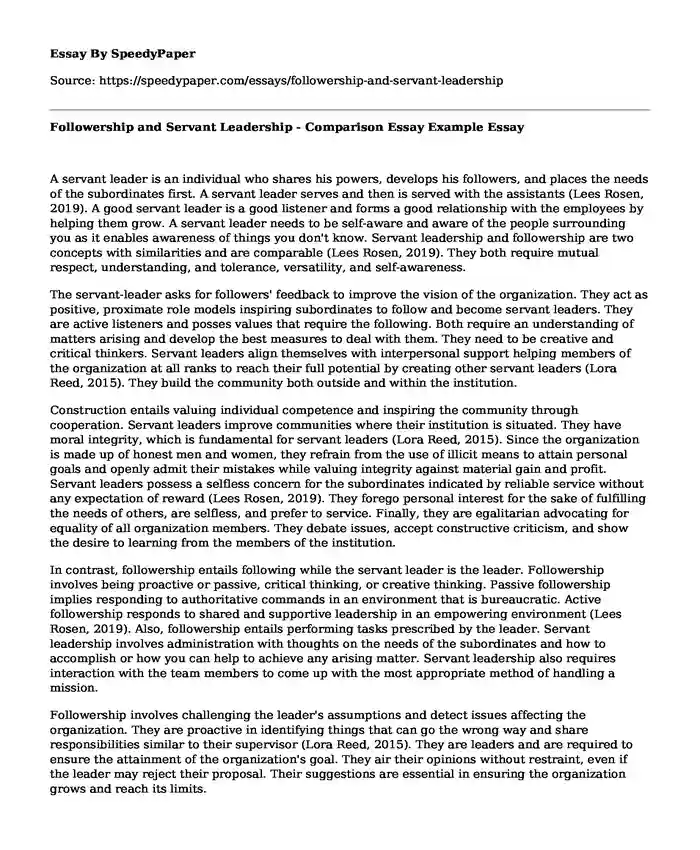
| Type of paper: | Essay |
| Categories: | Servant leadership Leadership style |
| Pages: | 3 |
| Wordcount: | 677 words |
A servant leader is an individual who shares his powers, develops his followers, and places the needs of the subordinates first. A servant leader serves and then is served with the assistants (Lees Rosen, 2019). A good servant leader is a good listener and forms a good relationship with the employees by helping them grow. A servant leader needs to be self-aware and aware of the people surrounding you as it enables awareness of things you don't know. Servant leadership and followership are two concepts with similarities and are comparable (Lees Rosen, 2019). They both require mutual respect, understanding, and tolerance, versatility, and self-awareness.
The servant-leader asks for followers' feedback to improve the vision of the organization. They act as positive, proximate role models inspiring subordinates to follow and become servant leaders. They are active listeners and posses values that require the following. Both require an understanding of matters arising and develop the best measures to deal with them. They need to be creative and critical thinkers. Servant leaders align themselves with interpersonal support helping members of the organization at all ranks to reach their full potential by creating other servant leaders (Lora Reed, 2015). They build the community both outside and within the institution.
Construction entails valuing individual competence and inspiring the community through cooperation. Servant leaders improve communities where their institution is situated. They have moral integrity, which is fundamental for servant leaders (Lora Reed, 2015). Since the organization is made up of honest men and women, they refrain from the use of illicit means to attain personal goals and openly admit their mistakes while valuing integrity against material gain and profit. Servant leaders possess a selfless concern for the subordinates indicated by reliable service without any expectation of reward (Lees Rosen, 2019). They forego personal interest for the sake of fulfilling the needs of others, are selfless, and prefer to service. Finally, they are egalitarian advocating for equality of all organization members. They debate issues, accept constructive criticism, and show the desire to learning from the members of the institution.
In contrast, followership entails following while the servant leader is the leader. Followership involves being proactive or passive, critical thinking, or creative thinking. Passive followership implies responding to authoritative commands in an environment that is bureaucratic. Active followership responds to shared and supportive leadership in an empowering environment (Lees Rosen, 2019). Also, followership entails performing tasks prescribed by the leader. Servant leadership involves administration with thoughts on the needs of the subordinates and how to accomplish or how you can help to achieve any arising matter. Servant leadership also requires interaction with the team members to come up with the most appropriate method of handling a mission.
Followership involves challenging the leader's assumptions and detect issues affecting the organization. They are proactive in identifying things that can go the wrong way and share responsibilities similar to their supervisor (Lora Reed, 2015). They are leaders and are required to ensure the attainment of the organization's goal. They air their opinions without restraint, even if the leader may reject their proposal. Their suggestions are essential in ensuring the organization grows and reach its limits.
Servant leadership and Followership Differences
Leader.
Role model.
Supervision.
Propose issues to the employees and listen to their opinions
Provide supportive instructions to the employees.
Willingly serve their employees without any expectations.
Think about the needs of the employees.
Ask for feedback from the subordinates. Similarities
Are self-conscious and self-aware
Are leaders on their own.
Work towards achieving organisation goals.
Posses moral integrity.
Require mutual respect, versatility, and understanding. Differences
Follower
Modeled to be future leaders.
Perform tasks for the organization.
Air their opinions even if it rejects the leader's proposal
Respond to supportive leadership.
Propose their needs to the leaders with expectations of the fulfilment of the obligations.
Provide feedback to the leaders.
References.
Lees Rosen. (2019, January 21). What are the similarities and differences in followership and servant leadership? Retrieved from https://leesrosen.net/what-is-the-similarities-and-differences-in-followership-and-servant-leadership/
Lora Reed. (2015). Implications of a National Study. Servant Leadership, Followership, and Organizational Citizenship Behaviors in 9-1-1 Emergency Communications Centers, 2(1), 71-94.
Cite this page
Followership and Servant Leadership - Comparison Essay Example. (2022, Feb 16). Retrieved from https://speedypaper.net/essays/followership-and-servant-leadership
Request Removal
If you are the original author of this essay and no longer wish to have it published on the SpeedyPaper website, please click below to request its removal:
- Nursing Education Essay Sample
- Influence of Society on the Individual Essay Samples
- Oedipus Complex and the Powder - Comparison Essay Sample
- Essay Sample on the Impact on the Children of Syrian Refugee Crisis
- Advertising in new media
- Free Essay: Criminal Investigation for a Homicide in an Apartment Building
- Essay Sample on Care of The Older Person
Popular categories




